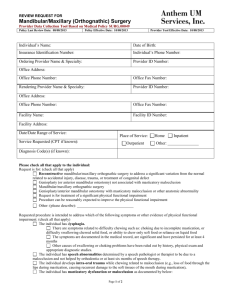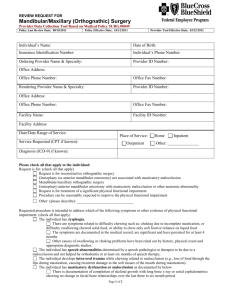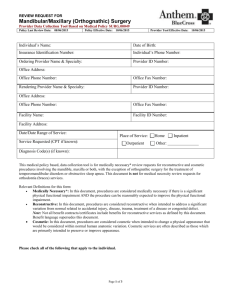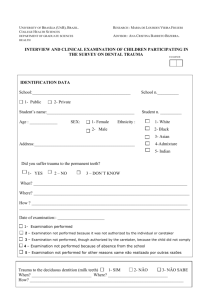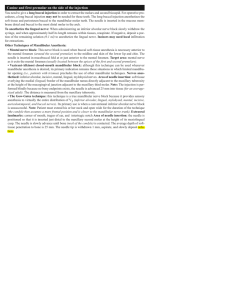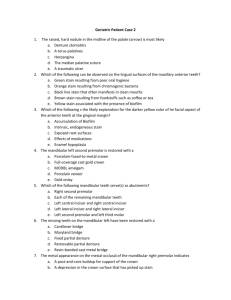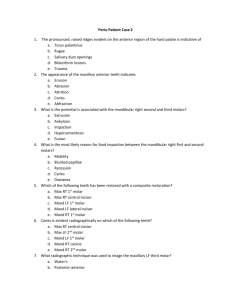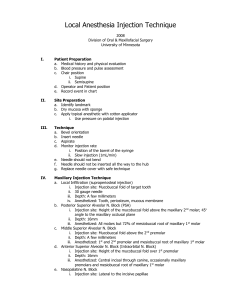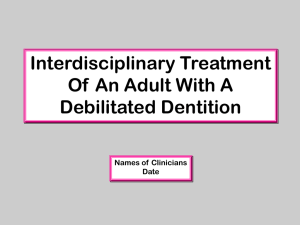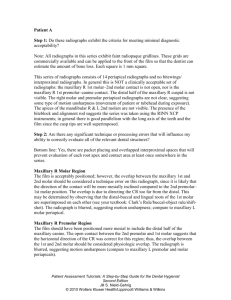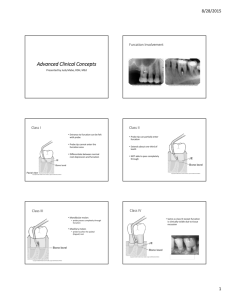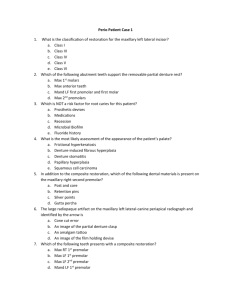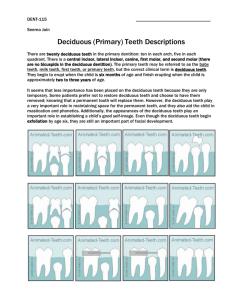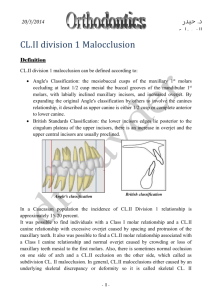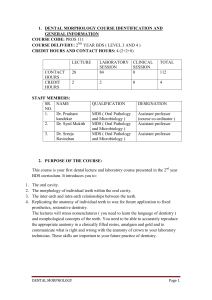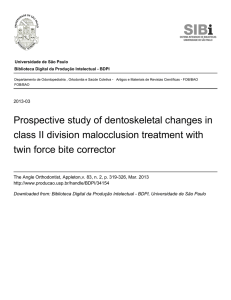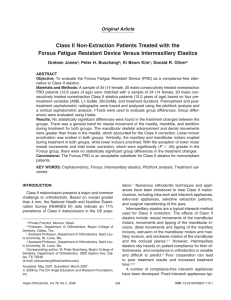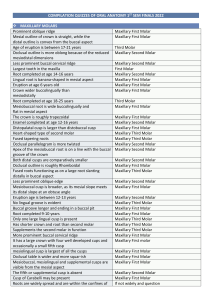Questions
advertisement
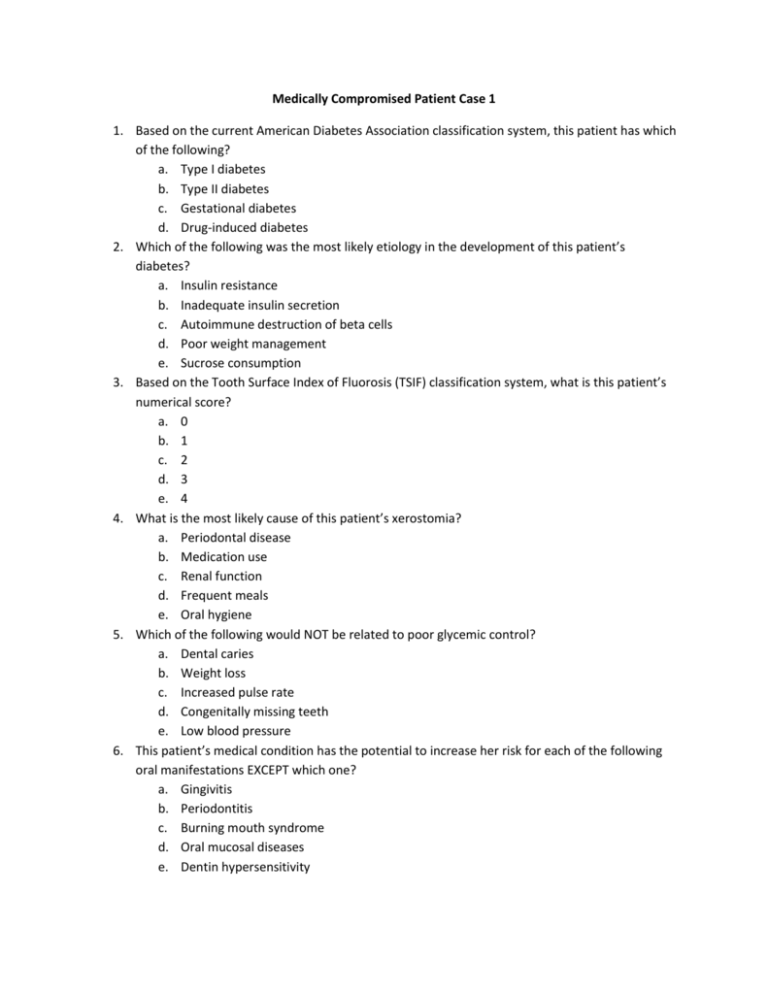
Medically Compromised Patient Case 1 1. Based on the current American Diabetes Association classification system, this patient has which of the following? a. Type I diabetes b. Type II diabetes c. Gestational diabetes d. Drug-induced diabetes 2. Which of the following was the most likely etiology in the development of this patient’s diabetes? a. Insulin resistance b. Inadequate insulin secretion c. Autoimmune destruction of beta cells d. Poor weight management e. Sucrose consumption 3. Based on the Tooth Surface Index of Fluorosis (TSIF) classification system, what is this patient’s numerical score? a. 0 b. 1 c. 2 d. 3 e. 4 4. What is the most likely cause of this patient’s xerostomia? a. Periodontal disease b. Medication use c. Renal function d. Frequent meals e. Oral hygiene 5. Which of the following would NOT be related to poor glycemic control? a. Dental caries b. Weight loss c. Increased pulse rate d. Congenitally missing teeth e. Low blood pressure 6. This patient’s medical condition has the potential to increase her risk for each of the following oral manifestations EXCEPT which one? a. Gingivitis b. Periodontitis c. Burning mouth syndrome d. Oral mucosal diseases e. Dentin hypersensitivity 7. Which of the following is the most likely interpretation of the round radiolucency at the incisal edge of the mandibular right central incisor observed in the mandibular right lateral canine periapical radiograph (arrow)? a. Film identification dot b. Composite restoration c. Attrition d. Calculus deposit e. Caries 8. Which of the following has rendered the maxillary right premolar periapical radiograph undiagnostic? a. Interproximal spaces overlapped b. Root apicies not visible c. Cone cutting present d. Herringbone effect e. Film holder imaged 9. What corrective action is required when retaking the undiagnostic maxillary right premolar periapical radiograph? a. Decrease the vertical angulation b. Shift the horizontal angulation to the mesial c. Ensure that the patient bites down on the film holder d. Reverse the film packet when placing into the oral cavity e. Center the film within the x-ray beam 10. Which of the following is the most likely interpretation of the radiolucent vertical line between the maxillary central incisors (arrow)? a. Nasal septum b. Nutrient canal c. Vertical bone loss d. Palatal fracture e. Midpalatine suture 11. The radiographs reveal which G.V.Black classification of caries on the maxillary left first molar? a. II b. III c. IV d. V e. VI 12. Which of the following is the most likely interpretation of the radiopaque anomaly near the roots of the mandibular left first molar (arrow)? a. Microdont b. Mesiodens c. Secondary dentin d. Enamel pearl e. Pulp stone 13. Which of the following teeth presents with root dilacerations? a. Maxillary right second premolar b. Maxillary left first molar c. Mandibular left canine d. Mandibular right central incisor e. Mandibular right second molar 14. Which of the following would be considered the most likely medical emergency that may occur with this patient during treatment? a. Hyperglycemia b. Hypoglycemia c. Diabetic coma d. Ketoacidosis 15. Each of the following indicated that this patient is experiencing a medical emergency EXCEPT which one? a. Excessive perspiration b. Bounding pulse c. Slight paresthesia d. Increased anxiety e. Argumentative mood 16. Which of the following will assist in managing a possible emergency medical situation regarding this patient? a. Premedicate with oral antibiotics b. Place ammonia capsule on the bracket table for ready use c. Request that the patient disconnect the insulin pump during treatment d. Use a semisupine chair position e. Have a source of oral sugar (orange juice) available 17. Based on the American Academy of Periodontology classification system, what is the patient’s periodontal classification? a. Gingivitis associated with dental plaque only b. Nonplaque-induced gingival disease c. Gingival disease modified by medications d. Gingival disease modified by systemic factors e. Gingival manifestations of systemic conditions 18. On a historic level, each of the following is responsible for the color change of the gingivae observed at the initial appointment in the facial region of the maxillary right central incisor EXCEPT which one? a. Blood flow to this area has increased b. Many dead and dying phagocytes are present c. Osteoclast activitiy is being stimulated by prostaglandins d. Leukocytes are invading the bacteria present at this site e. Plasma proteins are leaking from the blood vessels in the tissue 19. Periodontal disease may be considered a complication of diabetes. If this patient maintains control over her blood glucose levels, her risk for periodontal disease is likely to be no greater than that of nondiabetics. a. Both senteneces are true b. Both sentences are false c. The first sentence if true, the second is false d. The first sentence is false, the second is true 20. What is the reason for the change in appearance of the facial gingiva in the region of the mandibular right central incisor at the 6-week reevaluation appointment? a. Weight gain of los pounds b. Cessation of nail biting habit c. Change in method of insulin delivery d. Initiation of use of whitening products e. Periodontal debridement and improved self-care 21. Which of the following recare appointment intervals would benefit this patient? a. 1 month b. 3 months c. 6 months d. 9 months e. 12 months 22. Which of the following should be indicated for placement of a sealant? a. Maxillary right second molar b. Maxillary right first molar c. Maxillary left first molar d. Mandibular left first molar e. Mandibular right first molar 23. Which of the following would benefit this patient the most? a. End-tuft toothbrush b. Tooth whitening product c. Dietary assessment d. Self-applied fluoride e. Disclosing tablets 24. Which of the following can be expected to minimize tooth whitening results for this patient? a. Gingival inflammation b. Nail biting habit c. Fluorosis d. Diabetes e. Sealants 25. Each of the following is a recommended health history interview question to determine the safe treatment of this patient today EXCEPT which one? a. “Did you take your usual dose of insulin today?” b. “How often do you have insulin reactions?” c. “What was your blood glucose level at the last test?” d. “Have you eaten your normal meals and snacks today?” e. “How much do you weigh?” ANSWERS 1.A 2.C 3.B 4.C 5.D 6.E 7.A 8.B 9.C 10.E 11.A 12.D 13.A 14.B 15.C 16.E 17.D 18.C 19.A 20.E 21.B 22.A 23.D 24.C 25.E
